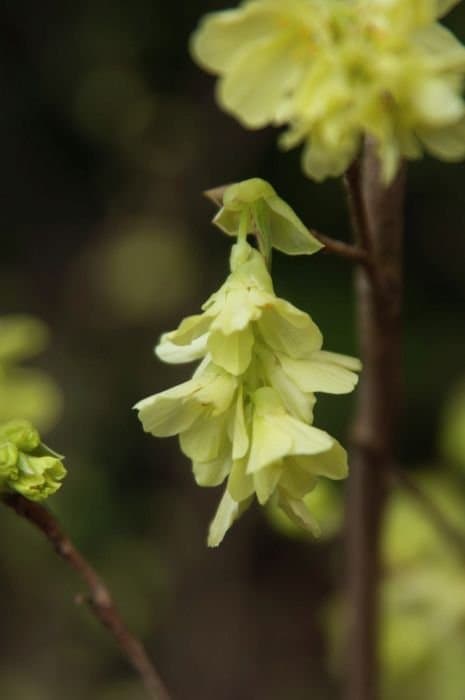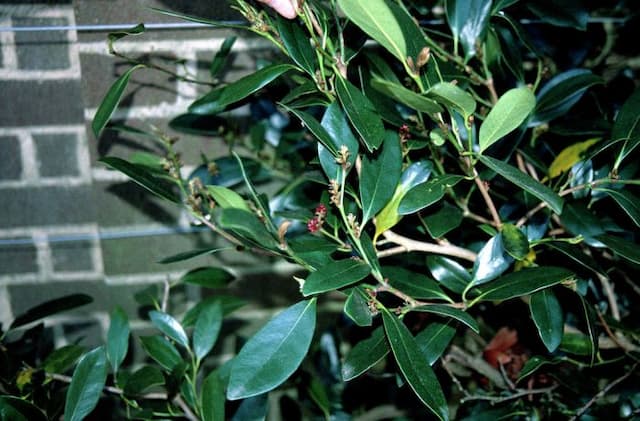Sweet gum 'Corky' Liquidambar styraciflua 'Corky'

ABOUT
'Corky' is an upright, narrowly pyramidal, deciduous, small to medium-sized tree up to 12m tall with deeply lobed, glossy green leaves that turn crimson red in autumn. Very pronounced wing-like, corky projections on the stems and bark are a feature of established trees. Inconspicuous greenish flowers may be followed by burr-like fruit, 2-4cm across, that stay on the tree through winter
About this plant
 Names
NamesFamily
Altingiaceae.
Synonyms
American Sweetgum, Red Gum, Sweet Gum, Star-Leaved Gum, Alligatorwood, Corky Sweet Gum.
Common names
Liquidambar styraciflua
 Characteristics
CharacteristicsLife cycle
Perennials
Foliage type
Deciduous
Color of leaves
Green
Height
60-70 feet (18-21 meters)
Spread
40-50 feet (12-15 meters)
Plant type
Tree
Hardiness zones
5-9
Native area
Eastern North America
Benefits
 General Benefits
General Benefits- Aesthetic appeal: The American Sweetgum 'Corky' has a distinctive pyramidal shape when young, which becomes more rounded with age, adding an architectural element to landscapes.
- Seasonal interest: It offers brilliant fall colors, with leaves turning vibrant shades of yellow, orange, red, and purple.
- Wildlife habitat: The tree provides food for birds and small mammals in the form of its spiky fruit capsules, known as gum balls.
- Shade provision: With its broad canopy, 'Corky' is excellent for creating large areas of shade, making outdoor spaces more comfortable during hot weather.
- Erosion control: Its extensive root system helps to stabilize the soil and prevent erosion, especially on slopes or in areas with loose earth.
 Medical Properties
Medical PropertiesThis plant is not used for medical purposes.
 Air-purifying Qualities
Air-purifying QualitiesThis plant is not specifically known for air purifying qualities.
 Other Uses
Other Uses- Liquidambar styraciflua 'Corky' wood is often used in fine woodworking for its beautiful grain and coloring, making it suitable for furniture, flooring, and paneling.
- The resin from the plant, known historically as storax or styrax, has been used in perfumery and as an incense ingredient due to its sweet, balsamic fragrance.
- The spiked fruits, or gumballs, can be used in craft projects and as a natural form of mulch to deter pests in the garden.
- As a source of tannin, the bark of Liquidambar styraciflua 'Corky' can be used in the tanning of leather.
- The tree can be tapped for sap in a manner similar to maples, and this sap can be made into a syrup or fermented into a type of beer.
- Liquidambar wood chips are used in smoking meats to impart a unique flavor that is different from traditional woods like hickory or mesquite.
- The dense wood is sometimes used in the creation of musical instruments because it has good acoustic properties.
- Artisans may use the branches and twigs for rustic weaving projects or as natural decor elements in floral arrangements.
- The tree's unique corky ridges can be studied in dendrology and education as an example of unusual bark adaptations.
- Liquidambar leaves can be used as a natural dye for fabrics, yielding colors that range from yellow to green depending on the mordant used.
Interesting Facts
 Feng Shui
Feng ShuiThe Sweetgum tree is not used in Feng Shui practice.
 Zodiac Sign Compitability
Zodiac Sign CompitabilityThe Sweetgum tree is not used in astrology practice.
 Plant Symbolism
Plant Symbolism- Change and Transformation: The Liquidambar styraciflua 'Corky', commonly known as Sweetgum, is renowned for its stunning autumn foliage that changes color. This symbolizes the beauty and inevitability of change.
- Healing: Sweetgum has been used in traditional medicine, representing the plant's connection to healing and therapeutics.
- Protection: The spiky gumball seed pods of the Sweetgum are often associated with protection, as they can seem like a natural deterrent to unwanted visitors in the plant world.
- Bounty and Provision: Sweetgum trees produce an abundance of seed pods, symbolizing generosity and provision.
 Water
WaterThe American Sweetgum 'Corky' should be watered thoroughly when the top 2 to 3 inches of soil are dry. Typically, this might mean watering once a week, but it can vary depending on climate and soil drainage. Each watering session should provide enough water to reach the root zone deeply, which would generally be around 15 to 20 gallons for a young tree, adjusting as the tree matures. During periods of drought or extreme heat, increase the frequency of watering. It's essential not to overwater, as this can lead to root rot and other diseases, so always check soil moisture before watering.
 Light
LightThe American Sweetgum 'Corky' thrives in full sunlight, which means it should receive at least 6 hours of direct sunlight each day. It can tolerate partial shade, but its growth will be optimal in a spot with unfiltered sunlight. Avoid planting it in a location that is too shadowed or receives only indirect light, as this can impede its development and vivid fall coloration.
 Temperature
TemperatureThe American Sweetgum 'Corky' is hardy and can withstand temperatures ranging from -10°F to over 100°F. However, the ideal conditions for this tree are temperate climates with temperatures sitting comfortably between 70°F and 85°F. It's resilient to brief periods of cold and heat but should be monitored during extreme weather conditions to ensure its health.
 Pruning
PruningPruning the American Sweetgum 'Corky' is essential for maintaining its shape, removing any dead or broken branches, and encouraging healthy growth. The best time to prune is in late winter or early spring before the new growth starts. Light pruning and removal of small branches can be done annually, but major pruning should be done infrequently and only as needed.
 Cleaning
CleaningAs needed
 Soil
SoilThe American Sweetgum 'Corky' thrives in well-draining soil rich in organic matter. A mix of loam, compost, and sand or perlite in equal parts creates an ideal soil structure. This tree prefers a slightly acidic to neutral pH, ranging from 5.5 to 7.0.
 Repotting
RepottingThe American Sweetgum 'Corky' typically does not require frequent repotting as it is a large tree. Seedlings or young trees might need repotting every 2-3 years until they are established enough to plant in the ground.
 Humidity & Misting
Humidity & MistingThe American Sweetgum 'Corky' is adaptable to various humidity levels but performs best in moderate to high humidity typical of outdoor environments.
 Suitable locations
Suitable locationsIndoor
Growing Sweetgum 'Corky' inside is challenging; ensure bright light, ample space.
Outdoor
Plant in sun, moist soil, space to grow; not typical for indoor cultivation.
Hardiness zone
The American Sweetgum 'Corky' is suitable for USDA zones 5-9.
 Life cycle
Life cycleLiquidambar styraciflua 'Corky', commonly known as the American Sweetgum, begins its life cycle as a seed, which after dispersal typically germinates in spring under suitable environmental conditions. The seedling stage follows germination, where the plant develops its root system and initial leaves to commence photosynthesis. As it enters the juvenile stage, the American Sweetgum grows rapidly, developing characteristic palmate leaves and beginning to form a woody stem. Reaching maturity after several years, the tree exhibits a corky bark and starts to produce its distinctive spiky fruit capsules, which contain numerous seeds. Throughout its reproductive phase, the American Sweetgum is capable of prolific seed production annually, often facilitated by wind for dispersal. With a lifespan that can exceed 100 years, the tree eventually enters a senescence phase, where growth slows and it becomes more susceptible to environmental stressors before dying.
 Propogation
PropogationPropogation time
Late winter
The American sweetgum, known botanically as Liquidambar styraciflua 'Corky', is most commonly propagated through seed. The best time to propagate sweetgum trees by seed is in the late winter or early spring. Seeds require stratification, which involves cold treatment for 1-2 months at around 40°F (4.4°C), to break dormancy. After stratification, seeds are sown in a well-draining soil mix and kept moist until germination, which should occur within a few weeks. Seedlings then need to be grown in a protected environment until they are strong enough to be transplanted outdoors, typically in the late spring or early fall, when the weather is mild and there is less threat of extreme temperature changes.









